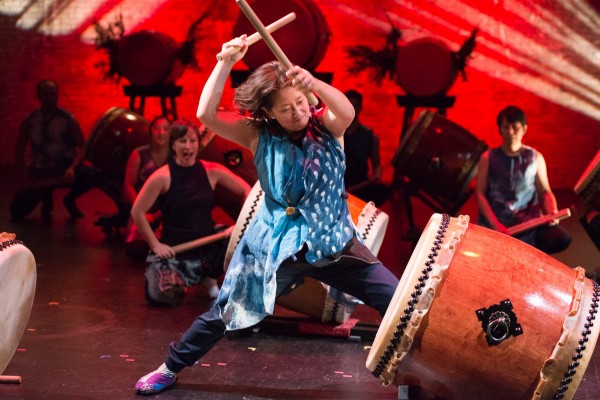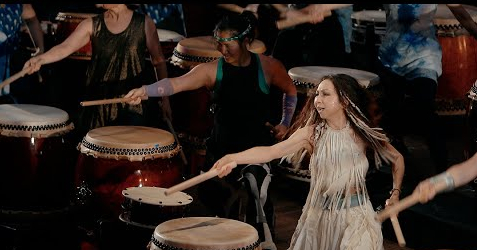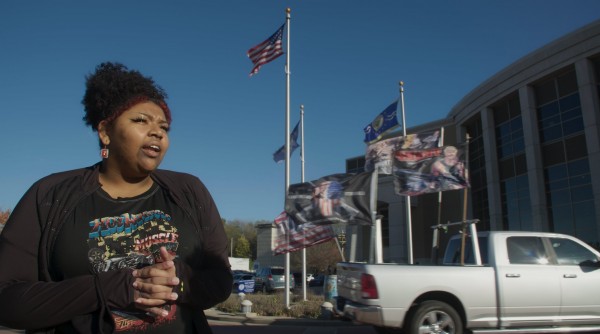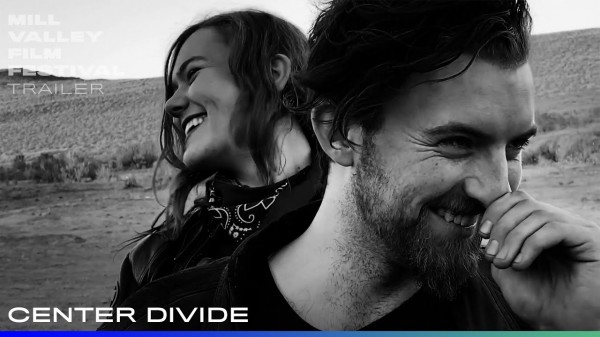-
FINDING HER BEAT (Dawn Mikkelson, Keri Pickett 2022)
DAWN MIKKELSON, KERI PICKETT: FINDING HER BEAT (2022)

JENNIFER WEIR IN FINDING HER BEAT
Women who have entered the macho world of Japanese Taiko drumming give a historic collective performance
Just between you and me, Japan has one of the most macho, misogynistic, women-manipulating of the first world cultures. This is not dwelt upon in this documentary. It is an enthusiastic postcard from some leading female Taiko drummers and from an historic concert they played in. But it is something that adds excitement to the story the film tells about women who have entered the formerly all male world of Taiko drumming, and who gather for a joint "HerBeat" performance in Minnesota in the dead of winter as the Coronavirus pandemic is coming.
It's a surprise since everything in Japanese culture seems to be ancient, to learn that while the big drums go back to the sixth century, Kumi-daiko, which an extensive Wikipedia article on "Taiko" tells us is the name for performing on Taiko for the public, didn't start till after WWII, in the fifties and sixties. It was only more recently that women wangled their way in. But it's also true that despite all the traditionally Japanese lore and ritual surrounding the drums and playing them, there are taiko drum groups all over, most notably in Australia, Brazil, North America and Italy. One can see in this dispersal and variety a wedge into Japanese hegemony and male domination, which isn't so rigid in other first world countries.
The focus is on some women who have made a mark in this field. The filmmakers follow them and interview them from Minnesota to Japan. The film climaxes and bookends with a "first time, historic" performance gathering some of the best women Taiko performers from Japan and North America at the Ordway Center for the Performing Arts in Saint Paul, Minnesota, including stars from Japan who had never played together in Japan. Jennifer Weir, who is of Japanese descent, and director of TaikoArts Midwest, is a leading figure of this event. She, her wife Megan Chao Smith (a Korean adoptee from North Dakota), and their daughter, Josie, who live in Minnesota, are featured. Megan lived, trained and toured with a professional performing Taiko group, in Japan, a great experience, though she withdrew from it because she thought it would be the end of her.
Also present here are Chieko Kojima, founding member of Kodo Taiko Performing Arts Ensemble, based on Sado island; Tiffany Tamrabuchi, a Taiko master based in Sacramento, California, who brought Chieko to California to perform years earlier; and Kaoly Asano, a dynamic performer with a sweeping mane of hair, who represents Gocoo, of Tokyo. They and more, including Mayumi Hashimoto and Iris Shiraishi, will be on stage for the exciting Minnesota performance. Many have Japanese names, many understand Japanese. Kaoly Asano is a person who keeps drawing our attention, because of her presence, her style, and the way she bravely integrates into what remains still primarily an Anglophone production effort. Her special piece called "Eleven" (referring to the March 11, 2011 Japan earthquake and tsunami, and also September 11) is one of the highlights of the show.
This film spends a lot of its time focusing on the run-up to the Minnesota show day by day, though it also manages to show highlights of the show itself. The planning and rehearsals are a complicated business, in which Jennifer works to let all the women be themselves yet coordinate them into a show while the winter temperatures are low and finally the Covid pandemic is creeping on and some of them get sick, while others are exhausted from the hard work, the close quarters with a lot of strangers, and the stress of Minnesota winter. Above all this is a celebration for these women of what they have accomplished and a sharing of their different life experiences all of which converged in dedication to Taiko. If we feel a little of what these very diverse performers and this lucky audience felt on this historic night in Saint Paul, the film will have succeeded. (I hope it was not a super-spreader event.)
Finding Her Beat is an ebullient and hopeful film that will appeal to music fans as well as feminists. It's a thoroughly conventional documentary in form, and just as the stage is crowded in the titular performance, there is the feeling that the dual directors are trying to cram a little too much in and might have fared better with fewer, more striking moments. But the feeling and the message are too strong to object.
Finding Her Beat, 129 mins., premieres at Mill Valley Oct. 9 and 11, 2022. Produced by TaikoArts Midwest and Emergence Pictures.

KAOLY ASANO AND "ELEVEN"
Last edited by Chris Knipp; 10-02-2022 at 09:59 PM.
-
THE YOUNG VOTE (Diane Robinson 2022)
DIANE ROBINSON: THE YOUNG VOTE (2022)

ARIANA IN THE YOUNG VOTE
A part of the vote that can change American politics
The director, Diane Robinson, has moved from education to filmmaking and this short documentary, hot off the press, is the result. It's a film about, and for, the younger generation of 18-29-year-old voters. They are now the largest block of voters and their power has not been felt. Though this is not a point of the film, because it would be inappropriate, we can note that, because they are predominantly liberal, this block of young voters could shift American politics away from the recent Fox News-promoted trend to the right.
The problem in the way of that is a feeling the young generation has of disaffection and hopelessness. It also emerges that US schools are weak on teaching civics. Kids grow up not even knowing how American government works, sometimes not really grasping that they live in a democracy.
We meet a succession of young US political activists. The articulate, vigorous Sophia, age 24, is a campaigner. Her first vote was for Hilary Clinton. Disappointed at Hilary's losing, she learned half the young vote - the largest younger voting generation in American history - didn't even participate in the election. Actually only 40%, 23.7 million, of the 18-29 age vote turned out at the polls. Young activists subsequently worked hard to change that, the film shows, and the 2020 national presidential election turnout had more youth vote than ever before.
Some young activists shown, rather than focusing on voting have taken to the streets to demonstrate in the wake of the death of George Floyd and the Black Lives Matter movement. Key in this are some leading activists like the Parkland kids who started #neveragain to fight the NRA and promote gun control after 17 at their school were killed. David Hogg, their most visible personality now, is seen giving a speech, but this group is mentioned, not directly interviewed.
Another focus of this film is the campaign for Amendment 3 in Florida to bring an open primary system so the two major parties don't control elections. There are still 15 states where the primaries still are sewn up by the two parties. (The Florida amendment lost, but California's won on the second vote, as saddened 16-year-old Elena, a Amendment 3 campaigner along with Dariel, notes.)
Still another focus is on gerrymandering, and other major efforts primarily by Republicans to reduce the vote in states all over the nation. It's been effective, but people have shown they'll still go out and vote even against all the obstacles, and the 2020 turnout was dramatically different from the 2016 one in which Trump won.
The cross section of activists includes Ariana, from Louiville, Kentucky, a university student activist who took to the streets and was arrested with her white high school teacher to protest police brutality and believes that is more important than voting right now. She and her white teacher were treated differently by police. Also important in the film is Liz, a DACA immigrant from Mexico who cannot vote but works as an activist in Dallas to get out eligible Latino voters.
I won't go into all the many salient facts and numerous vibrant young activists heard from Suffice it to say that this film is informative for anyone. But it might best be watched by young Americans, voters or not (such as Liz). They need to be informed, they need to vote, and this documentary makes that clear and is full of inspiring role models.
This clear, urgent film shows talking-heads docs can still matter. The numerous young activists who speak show young viewers that people who look like them are out there fighting to get out the vote, and they can too.
The Young Vote,, 67 mins., debuted as a selection in June 2022 at the American Black Film Festival (Miami Beach, FLA), was a recppient of a Black Voices for Black Justice awards and an Impact Docs Award. Other information can be found on the film website. It was screened for this review as a part of Mill Valley 2022.
Last edited by Chris Knipp; 10-02-2022 at 10:10 PM.
-
FAULTLINE (Rob Nilsson 2022)
ROB NILSSON: FAULTLINE (2022) MVFF45

In stark western landscapes, the search for the father comes to an end
This is the third feature in eighty-something filmmaker Rob Nilsson's vivid, multi-character black and white Nomad Trilogy saga. The first two are Arid Cut and Center Divide and they are all held together by a young couple, Rail (Nighttrain Schickele) and Mitra (Emily Corbo) traveling across the American West. The guy, Rail, is looking for his father, Bert Neville, whom he has never met. All three features have been introduced at successive Mill Valley Film Festivals, in 2019, 2021, and 2022. Originally inspired by John Cassavetes' 1959 improvisational classic Shadows, Nilsson puts together his films through finding people to act in scenes and having them improvise, building the individual scenes largely around the people through the course of his "citizen cinema workshops." The film, shot on two handheld iPhone 11's, has a rich, evocative contrastiness, like the photographs of Bill Brandt or the late Willliam Klein, and make much use of closeups and intense, emphatic dialog. If one reads the three summaries of the trilogy's parts on IMDb, one understands why Nilsson has his own definition of the word "epic."
In the first film in the trilogy, Arid Cut, homeless people driven out of an encampment because a race track is being demolished head out for open country. A couple of lovers on a motorcycle are going north (Rail and his girl) going to look for a place called Arid Cut in search of his father. Why Arid Cut? Because Rail has found a book by that title by Bert Neville.) There is also a group of wildcat carpenters and a stowaway, and other characters. The second film, Center Divide,is a road movie wherein various travelers meet up and the search for Arid Cut (not on any map) continues. Part three, Faultline, the present film, takes place deep in the desert in Nevada and Northern California and a couple of ranches that they find. I am quoting here from Rob Nilsson himself in a 2021 MVFF interview where he was talking about Center Divide, which debuted then.
Some pungent scenes early on in Faultline occur in bars, a favorite venue for Nnilsson. I like how one character declares that most of the world's conspiracy theories originate in bars and move out from there. Rail and Mitra first met, they say, dancing in a skateboard park, but they have a tendency to squabble. After one such argument Rail goes off leaving Mitra in a bar, where the venerable lady bartender offers to give her a place to stay till she decides what to do. Rail goes off to find some friends who get in touch to say they are lost in a wilderness. We are in Modoc County and Rail declares himself to be part Modoc tribe. Eventually he and Mitra are reunited, and eventually he finds a man who says he is a father and they embrace and the father declares his love, but the father tells Rail not to come around any more. And the film ends with a trail of figures silhouetted across a dramatic horizon, like in Ingmar Bergman's Seventh Seal. There are no shootouts, guns drawn, or Cormac McCarthy bloodbaths here, but the personalities seem very western, as is the intentional turning away from cities and embrace of the desert.
The Bergmanesque scene shows Nilsson aspires to grandeur, and he likes by his own admission to steal for a moment the most "epic" natural settings. His workshopping means of production on the other hand draws often on both stylish and humble, craggy qualities in the people he films with his intense iPhone lenses. The acting is homegrown and works sometimes better than others. The editing is smooth and pretty inventive, but there are longueurs and inexplicable jumps. Maybe this didn't need to run for 155 minutes. Sometimes the journey could have moved forward faster toward its conclusion. Rob Nilsson films are an acquired taste. What seemed most satisfying from first frame to last was the cinematography. Faultline really has an impressive, dramatic look. The sharp chiaroscuro black and white images of faces, figures and interiors or landscapes are always framed handsomely.
Besides Train Schickele and Emily Corbo as Rail and Mitra, other lead actors are Russell Murphy as Travis, Tony Milliner as Ziggy, Lydia Becker as Karin, Don Bejema as Bed, Dan Da Silva as Dane, Mia Perez as April, Zelma Iveson as Zelma, Rosemary Nelso(n as Violet, Chris Damm as Ben, Galina Paasternak as Svetlana, Puneet as RP, and Dante Dunn as Taylor. Twenty-seven other cast members are listed in ther closing credits.) An article by Andrew Gilbert in Berkeleyside last year about the middle picture reveals that Nighttrain Schickele himself has "only vague memories" of his late father, David Schickele, who was a "musician, actor, and filmmaker "whose precious few films are being preserved by the Pacific Film Archive." But then, separating life from art is rarely a simple equation in the world of Rob Nilsson. The confluence between actor and character, Gilbert points out, is typical of Nilsson's way of working. He doesn't like to use "actors" but make fictions out of people "being themselves." The article provides more about Nilsson's loose production company, Bricolage, and is key members, as well about his working method and the philosophy behind it. As much as his sui generis filmmaking, Nilsson is notable for how clear and well worked out the ideas behind that filmmaking is. That may be as memorable as the work itself. He expresses some of his lively ideas about current cinema and reviews his own work in a 5,000-word piece in a July 2021 issue of Senses of Cinema. There is very little else to be found about him on the internet.
Faultline, 155 mins., debuts at Mill Valley Film Festival Oct. 2022. Rob Nilsson received the 1979 Camera d’Or at Cannes for his feature Northern Lights and the Grand Jury Dramatic prize at Sundance for his 1987 Heat and Sunlight. He is currently receiving numerous lifetime achievement honors at international film festivals.
Last edited by Chris Knipp; 11-02-2022 at 09:11 PM.
 Posting Permissions
Posting Permissions
- You may not post new threads
- You may not post replies
- You may not post attachments
- You may not edit your posts
-
Forum Rules






 Reply With Quote
Reply With Quote


Bookmarks